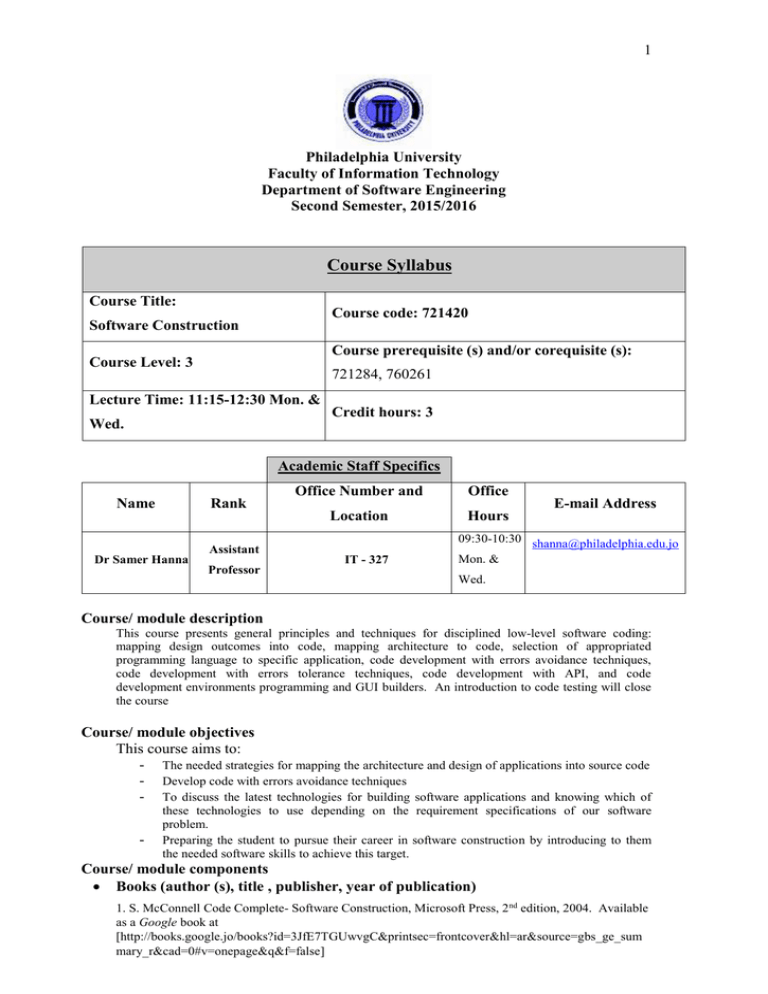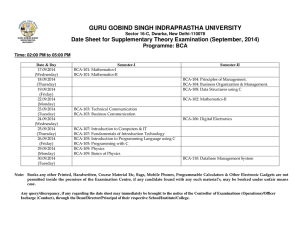
1
Philadelphia University
Faculty of Information Technology
Department of Software Engineering
Second Semester, 2015/2016
Course Syllabus
Course Title:
Course code: 721420
Software Construction
Course prerequisite (s) and/or corequisite (s):
Course Level: 3
721284, 760261
Lecture Time: 11:15-12:30 Mon. &
Wed.
Credit hours: 3
Academic Staff Specifics
Name
Rank
Dr Samer Hanna
Assistant
Professor
Office Number and
Office
Location
Hours
IT - 327
E-mail Address
09:30-10:30 shanna@philadelphia.edu.jo
Mon. &
Wed.
Course/ module description
This course presents general principles and techniques for disciplined low-level software coding:
mapping design outcomes into code, mapping architecture to code, selection of appropriated
programming language to specific application, code development with errors avoidance techniques,
code development with errors tolerance techniques, code development with API, and code
development environments programming and GUI builders. An introduction to code testing will close
the course
Course/ module objectives
This course aims to:
- The needed strategies for mapping the architecture and design of applications into source code
- Develop code with errors avoidance techniques
- To discuss the latest technologies for building software applications and knowing which of
-
these technologies to use depending on the requirement specifications of our software
problem.
Preparing the student to pursue their career in software construction by introducing to them
the needed software skills to achieve this target.
Course/ module components
Books (author (s), title , publisher, year of publication)
1. S. McConnell Code Complete- Software Construction, Microsoft Press, 2nd edition, 2004. Available
as a Google book at
[http://books.google.jo/books?id=3JfE7TGUwvgC&printsec=frontcover&hl=ar&source=gbs_ge_sum
mary_r&cad=0#v=onepage&q&f=false]
2
2. B. Buegge & A. Dutoit, "Object-Oriented Software Engineering, using UML, Pattern and Java",
Second Edition, 2004.
3. R. N. Taylor, N. Medvidovic and E. Dashofy, “Software Architecture Foundations, Theory, And
practice” John Wiley & Sons, 2010.
Support material (s)
Study guide (s) (if applicable)
-Part1/ mapping design to code techniques
- Part II/coding techniques and tools
Homework and laboratory guide (s) if (applicable)
- attached Homework and Practical work sheet
Teaching methods
Duration: 16 weeks, 60 hours in total. Lectures: 30 hours, 2 per week. Tutorial: 12, 1 per week.
Laboratories: 3 in lab and 15 hours in total, 1-hour per week (personal). The last week is reserved to
practical works examination.
Learning outcomes
A student completing this module unit should be able to:
Knowledge and understanding of
1. The methods and processes that should be followed to map a certain
requirement, architecture or design of a software application to the
corresponding implementation. (A2, A3)
2. The current available software technologies and justifying which of these
technologies to choose depending on the problem to be solved. (A2)
3. The needed methods to correctly implement and document solutions to
significant computational problems. (A2, A3)
4. The application of computing in a business context. (A8)
5. The needed methods to debug a program using appropriate debugging
strategies and distinguish between error types. (A2)
6. Evaluation of the tools and techniques in software construction. (A2)
7. The knowledge to develop software applications in development environment
that makes use of commonly supported tools. (A2)
Cognitive skills (thinking and analysis)
8. Analyze a software problem or architecture and think of the most proper way to
map them to the suitable programming language and technology. (B2)
9. Design, write and debug computer programs in appropriate languages. (B3)
10. Solve real software construction problems from the software industry. (B3)
11. Identify a range of solutions and critically evaluate and justify proposed
design solutions. (B4)
12. Analyze, transform, improve, and validate software applications. (B2)
13. Evaluate software applications in terms of general quality attributes and
possible trade-offs presented within the given problem. (B6)
Practical skills
14. Use API libraries for software construction. (C1)
15. Write code in both Java and C# programming languages (C3)
16. Develop desktop and Web applications (C3).
17. Prepare and deliver coherent and structured verbal and written technical
report.(C7)
18. Use the scientific literature effectively. (C8)
3
Transferable skills
19. Process data. (D1)
20. Solve problems (D3)
21. Use creativity (D2)
22. Communicate effectively with non-specialist as well as computer scientist,
(D4)
23. Give oral presentations and write report and technical documents. (D5)
Assessment of Learning Outcomes
Learning outcomes (1-7) are assessed by examinations. Learning outcomes (8-23) are
assessed by tutorials, laboratory work, projects and examinations.
Assessment instruments
Class works: 15
(project and quizzes)
Practice (construction tool): 05
Final examination: 40
Short Examinations: 2 x 20
Allocation of Marks
Assessment Instruments
Mark
First examination
20
Second examination
20
Final examination: 40 marks
40
Reports, research projects, Quizzes, Home
20
works, Projects
Total
100
Documentation and academic honesty
Documentation style (with illustrative examples)
- Practical works reports must be presented according to the style specified in the homework and practical work
guide
Protection by copyright
Avoiding plagiarism
- Any stated plagiarism leads to an academic penalty
Course/module academic calendar
Basic and support material to be covered
week
(1)
(2)
(3)
a. Introduction to Software Construction such as: its importance, involved tasks and
activities, types etc.
b. Background about the architecture and detailed design of software applications
Implementation Strategies (Available techniques to assist in the development of the
implementation from the design including: generation technologies, frameworks and
middleware, and reuse.
Mapping design outcomes into Code/ derivation of code from design models
- Application of Object Model (Class Diagram): UML
Practical Work
(PW) and
Examinations
1st PW
4
(4)
(5)
(6)
(7)
(8)
(9)
(10)
(11)
(12)
(13)
(14)
(15)
(16)
Mapping the Object Model to a Database Schema
Construction tools technology/ Techniques and tools supporting code dev.
API use, Code reuse and libraries
Steps of Building a Routine
Constructing a routine by using the Pseudocode Programming Process (PPP)
First examination
Choosing the appropriate programming language depending on the requirement
specifications (Discussing the characteristics of the well-known programming languages
and when each of them can be used)
Defensive Programming
2nd PW
Error Handling Techniques
Code-Tuning Strategies
Error avoidance Vulnerable techniques: Program Flow Control breaking (goto, continue,
exit, break, …), Recursion, Global data, parameters by value and by references
Second examination
Service Oriented Architecture (SOA) and Web Services (A new paradigm of building
software applications)
Distributed Middlewares
3rd PW
Software construction Tools/
Development environments, GUI builders
-1
- Unit testing tools
Practical Exam
Final Examination
Expected workload
On average students need to spend 2 hours of study and preparation for each 50-minute
lecture/tutorial.
Attendance policy
Absence from lectures and/or tutorials shall not exceed 15%. Students who exceed the 15%
limit without a medical or emergency excuse acceptable to and approved by the Dean of
the relevant college/faculty hall not be allowed to take the final examination and shall
receive a mark of zero for the course. If the excuse is approved by the Dean, the student
shall be considered to have withdrawn from the course.
Module references
Books
1. M. Blaha and J. Rumbaugh, “Object-Oriented Modeling and Design with UML”, Second editions
PEARSON Prentice Hall 2005.
2. D. Brugali and M. Torchiano, "Software Development Case Studies in Java", Addison Wesley,
2005.
3. P. Tahchiev, F. Leme, V. Massol and G. Gregory, "JUnit in Action", Second Edition, MANNING,
2011.


